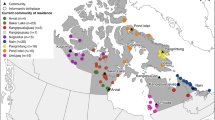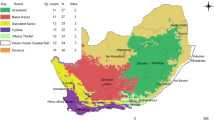Abstract
This paper examines the abundance and Aboriginal use of botanical non-timber forest products in the Gwich’in Settlement Area in the Northwest Territories, Canada. Informants indicated that wild berries are important to Gwich’in diets and an important factor in culture and traditional land use. People collected mostly cloudberries (Rubus chamaemorus), blueberries (Vaccinium uliginosum), and lingonberries (Vaccinium vitisidaea). The total quantities collected were estimated to be greater than other published accounts of berry gathering by northern Aboriginal peoples in North America. The total collected by the 450 households in the year 2000 was about 16,000 L. Inventories of wild berries on the landscape suggest that substantial quantities could be collected for commercial production, although the between-year supply can show considerable variation.
Similar content being viewed by others
Literature Cited
Andre, A., andA. Fehr. 2001. Gwich’in ethnobotany: Plants used by the Gwich’in for food, medicine, shelter and tools. Gwich’in Social and Cultural Institute and Aurora Research Institute Publishers, Inuvik, Northwest Territories, Canada.
Arctic Monitoring and Assessment Program. 1997. Arctic pollution issues: A state of the Arctic environment report. AMAR Oslo, Norway.
Berkes, F., A. Hughes, P. J. George, R. J. Preston, B. D. Cummins, andJ. Turner. 1995. The persistence of Aboriginal land use: Fish and wildlife harvest areas in the Hudson and James Bay lowland, Ontario. Arctic 48:81–93.
—,P. J. George, R. J. Preston, A. Huggins, J. Turner, andB. D. Cummins. 1984. Wildlife harvesting and sustainable regional native economy in the Hudson and James Bay lowland, Ontario. Arctic 47:350–360.
Boxall, P. C., G. Murray, andJ. R. Unterschultz. 2003. Non-timber forest product potential from the Canadian boreal forest: An exploration of Aboriginal opportunities in the wild berry industry. Journal of Forest Economics 9:75–96.
Brubacher, D. 1999. Non-timber forest products: Exploring opportunities for Aboriginal communities. National Aboriginal Forestry Association, Ottawa, Ontario.
Brumbach, H. J., andR. Jarvenpa. 1997. Ethnoarchaelogy of subsistence space and gender: A subarctic Dene case. American Antiquity 62:414–436.
Chapeskie, D. 1997. The maple syrup industry in Ontario. Ontario Ministry of Agriculture, Food and Rural Affairs-Agroforestry. http://www.gov.on.ca/ OMAFRA/english/crops/facts/maple.htm
Cody, W. J. 1996. Flora of the Yukon Territory. National Research Council of Canada, Ottawa, Ontario.
Duchesne, L. C., J. C. Zasada, andI. DavidsonHunt. 2000. Nontimber forest product industry in Canada: Scope and research needs. Forestry Chronicle 76:743–746.
Eidlitz Kuoljok, K. 1969. Food and emergency food in the circumpolar area. Studia Ethnographica Upsaliensia Vol. 32. Almqvist and Wiksells, Uppsala, Sweden.
Environment Canada. 2002. http://weatheroffice.ec. gc.ca/saisons/index_e.html, accessed June 11, 2002.
Gilman, A., E. Dewailly, M. Feeley, V. Jerome, H. Kuhlein, B. Kwavnick, S. Neve, B. Tracy, P. Usher, J. Van Oostdam, J. Walker, andB. Wheatley. 1997. Chapter 4: Human Health. Pages 295–377 in J. Jensen, K. Adare, and R. Shearer, eds., Canadian Arctic contaminants assessment report. Indian and Northern Affairs Canada, Ottawa, Ontario.
Gottesfeld, L. M. J. 1994. Conservation, territory, and traditional beliefs: An analysis of Gitksan and Wet’suwet’en subsistence, northwest British Columbia, Canada. Human Ecology 22(4):443–465.
Hultén, E. 1968. Flora of Alaska and neighboring territories. Stanford University Press, Stanford, CA. Http://weatheroffice. ec. gc. ca/saisons/index_e, html/ Date accessed June 11, 2002.
Jarvenpa, R. 1976. Spatial and ecological factors in the annual economic cycle of the English River Band of Chipewyan. Arctic Anthropology 13:43–69.
Kuhnlein, H. V., andN. J. Turner. 1991. Traditional plant foods of Canadian indigenous peoples: Nutrition, botany, and use. Gordon and Breach Science Publishers, Philadelphia, PA.
Mackey, M. G. A., andR. D. Orr. 1987. An evaluation of household country food use in Makkovik, Labrador, July 1980-June 1981. Arctic 40:60–65.
Maries, R., C. Clavelle, L. Monteleone, N. Tays, andD. Burns. 2000. Aboriginal plant use in Canada’s northwest boreal forest. Natural Resource Canada and UBC Press, Vancouver, British Columbia.
Mater Engineering Limited. 1993. Special forest products market analysis (for Saskatchewan Timberlands Division, Weyerhaeuser Canada Ltd.). Canada-Saskatchewan Partnership Agreement in Forestry Project No. 3017. Canadian Forest Service, Edmonton, Alberta.
Mohammed, G. H. 1999. Non-timber forest products in Ontario: An overview. Forest Research Information Paper No. 145. Ontario Forest Research Institute, Ontario, Ministry of Natural Resources, Sault Ste. Marie, Ontario.
Murray, A. E. 2002. Learning about the land: Tetlit Gwich’in perspective on sustainable resource use. MA thesis, University of Alberta, Edmonton, Alberta.
Parlee, B., F. Berkes, and Teetl’it Gwich’in Renewable Resource Council. 2004. Indigenous knowledge of ecological variability and commons management: A case study on berry harvesting from northern Canada. Human Ecology (forthcoming).
Porsild, A. E., andW. J. Cody. 1980. Vascular plants of the continental Northwest Territories. National Museums of Canada, Ottawa, Ontario.
Raatikainen, M., andT. Raatikainen. 1983. The berry yield, picking and marketing ofVaccinium myrtillus in the commune of Pihtipudus, Northern Central Finland. Silva Fennica 17:113–123.
—,E. Rossi, J. Huovinen, M-L. Koskela, M. Niemalä, andT. Raatikainen. 1984. The yield of the edible wild berries in Central Finland. Silva Fennica 18:199–219.
Rossi, E., M. Raatikainen, J. Huovinen, M-L. Koskela, andM. Niemalä. 1984. The picking and use of edible wild berries in Central Finland. Silva Fennica 18:221–236.
Salo, K. Non-timber forest products and their utilization. Pages 117-156 in M. Hytönen, ed., Multiple-use forestry in the Nordic countries. Gummerus Printing, Jyväskylä, Finland.
— 1985b. Wild-berry and edible-mushrooms picking in Suomussalmi and in some North Karelian communes, Eastern Finland. Folia Forestalia 621:22–25.
Schlosser, W. E., andK. A. Blatner. 1995. The wild edible mushroom industry of Idaho, Oregon and Washington: A 1992 survey of processors. Journal of Forestry 93:31–36.
Thornton, T. F. 1999. Tleikw aaní, the “berried” landscape: The structure of Tlingit edible fruit resources at Glacier Bay, Alaska. Journal of Ethnobotany 19:27–48.
Tobias, T. N., andJ. J. Kay. 1993. The bush harvest in Pinehouse, Saskatchewan, Canada. Arctic 47: 207–221.
Wein, E. E., andM. M. R. Freeman. 1992. Inuvialuit food use and food preferences in Aklavik, Northwest Territories, Canada. Arctic Medical Research 51:159–172.
—, andM. M. R. Freeman. 1995. Frequency of traditional food use by three Yukon First Nations living in four communities. Arctic 48:161–171.
—,M. M. R. Freeman, andJ. C. Makus. 1996. Use of and preference for traditional foods among the Belcher Island Inuit. Arctic 49:256–264.
Author information
Authors and Affiliations
Rights and permissions
About this article
Cite this article
Murray, G., Boxall, P.C. & Wein, R.W. Distribution, abundance, and utilization of wild berries by the gwich’in people in the Mackenzie River Delta region. Econ Bot 59, 174–184 (2005). https://doi.org/10.1663/0013-0001(2005)059[0174:DAAUOW]2.0.CO;2
Received:
Accepted:
Issue Date:
DOI: https://doi.org/10.1663/0013-0001(2005)059[0174:DAAUOW]2.0.CO;2




